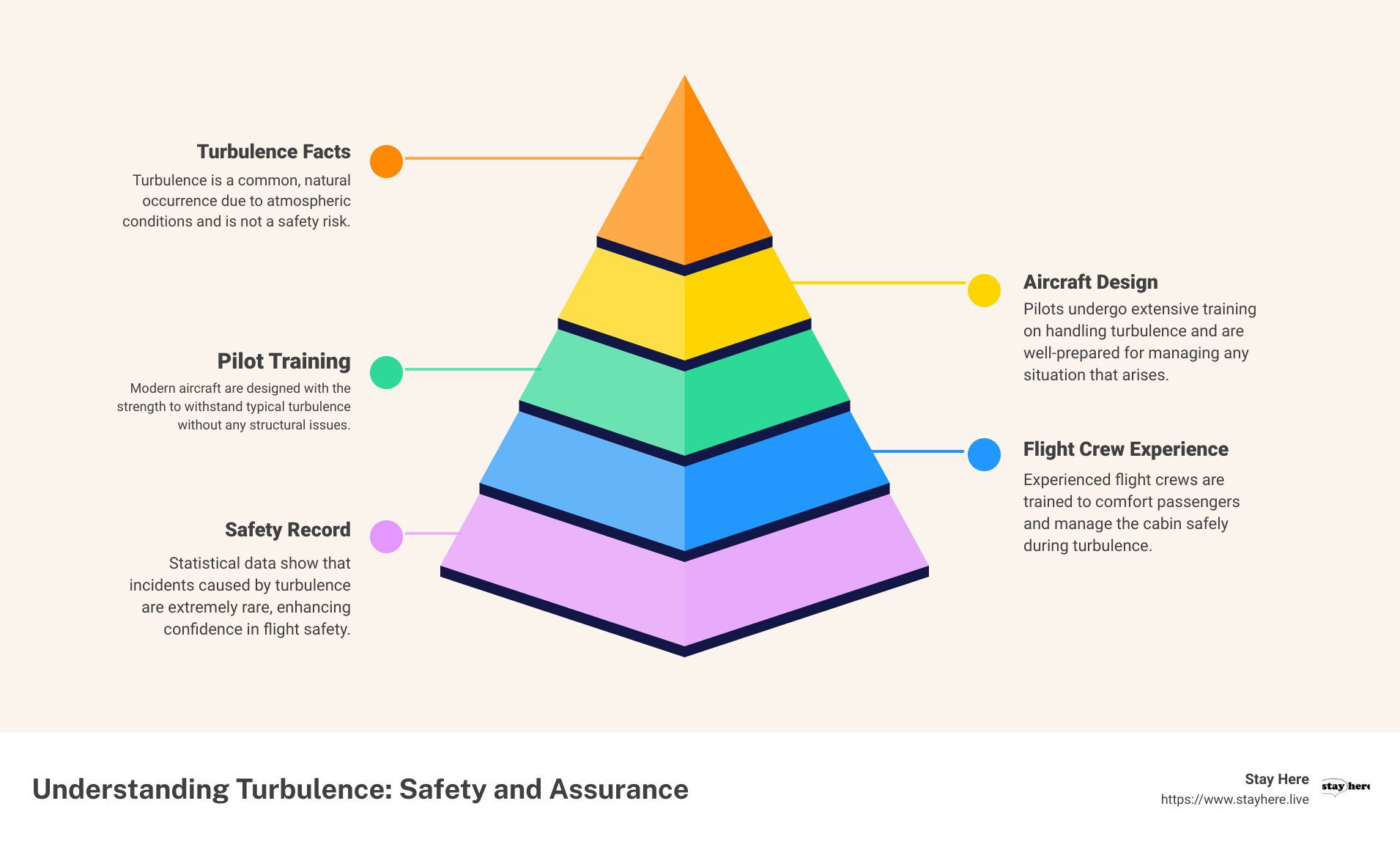How to Overcome Turbulence Anxiety in 5 Easy-to-Follow Steps
How to Deal with Turbulence Anxiety: If you struggle with fear during bumpy flights, here are concise tips: Trust your flight crew, choose seats over the wings or at the front, use turbulence forecast tools, practice relaxation techniques, and keep yourself distracted with activities you enjoy.
Introduction
Experiencing anxiety during turbulence is common, especially among new or infrequent flyers. However, understanding what causes this discomfort can help you manage your fear effectively.
Turbulence is essentially irregular motion that an aircraft encounters in the atmosphere, often due to weather patterns, terrain, or other natural factors. Although it might feel unsettling, turbulence is standard and generally harmless, managed expertly by trained pilots and durable aircraft designed to handle such conditions.
For many, the anxiety stems less from the turbulence itself than from feared outcomes it might suggest. Addressing this fear starts with understanding the triggers — identifying the thoughts or conditions that heighten your anxiety, so you can address them directly.
By acknowledging these triggers and grounding your understanding in facts, you can start your journey toward a calmer flight experience.
Recognize and Understand Your Fear
Turbulence Facts
First, know this: turbulence is a common and natural part of flying. It happens when the plane moves through irregular air motion, often caused by weather patterns, jet streams, or geographical features. Despite how unsettling it can feel, turbulence is a routine, anticipated occurrence that pilots and planes are well-equipped to handle. It's rare for turbulence to cause severe issues. In fact, planes are designed with the strength to endure much higher levels of stress than any turbulence you might experience during a flight.
Aircraft Design
Modern aircraft are engineering marvels designed to withstand not just turbulence but also more severe stress tests during their design and testing phases. The wings, for instance, can flex far more than you'll ever see during a flight; they're built to bend and absorb intense forces. The overall structure of the plane is equally robust, ensuring that even during unexpected rough patches, the aircraft's integrity is unimpaired.
Pilot Training
Pilots undergo rigorous training that includes extensive simulation of various flight scenarios, including handling severe turbulence. They learn about the dynamics of turbulence, how to navigate through it safely, and how to minimize discomfort for passengers. Pilots are professionals who have often flown hundreds, if not thousands, of flights. They are trained to remain calm and collected, ensuring everyone's safety with practiced ease.
Flight Crew Experience
Flight attendants, too, are well-trained in dealing with turbulence. They know how to secure the cabin quickly, reassure passengers, and manage safety protocols effectively. Their calm demeanor during turbulence is a result of specific training and numerous experiences. They are there to help you, so don't hesitate to express your concerns—they can provide reassurance and support.
By understanding these aspects of flying, you can reinforce your confidence in the safety measures and skilled professionals who make air travel one of the safest modes of transportation. This knowledge can significantly alleviate your anxiety, helping you to how to deal with turbulence anxiety more effectively.
Practical Tips Before and During Your Flight
Choose Your Seat Wisely
To minimize the feeling of turbulence, choose a seat over the wings or at the front of the plane. These areas are known for having less movement because they are close to the plane's center of gravity. Seats over the wings will feel more stable, while those at the front will experience less motion compared to the back.
Trust the Flight Crew
The pilots and flight attendants are highly trained to handle turbulence. Listen to the pilot's announcements; they often provide updates about expected turbulence and weather conditions. Flight attendants are also there to reassure you. They deal with turbulence regularly and are trained to keep passengers safe and comfortable.
Stay Informed
Before your flight, check weather forecasts and use turbulence forecast tools to know what to expect. This can help you prepare mentally and reduce surprises. Being informed gives you a sense of control, which is crucial in managing anxiety.
Practice Relaxation Techniques
Engage in simple relaxation strategies such as breathing exercises and grounding techniques. The 4-7-8 breathing method (inhale for 4 seconds, hold for 7 seconds, and exhale for 8 seconds) is effective in calming the nervous system. Additionally, the 3-3-3 method—noticing 3 objects, sounds, and movements—can help distract your mind and reduce feelings of anxiety.
Distract Yourself
Distracting yourself is one of the best ways to cope with turbulence. Bring along a good book, watch movies, listen to music, or play games. Consider using noise-canceling headphones to block out unsettling sounds of the aircraft. Engaging in activities you enjoy can make the time pass faster and divert your attention away from the turbulence.
By implementing these practical tips, you can feel more prepared and less anxious during your flight. Each strategy offers a way to manage your response to turbulence, helping you to maintain calm and enjoy your journey. Turbulence is usually short-lived, and focusing on these techniques can significantly ease your anxiety.
Professional Help and Support
When practical strategies aren't enough to manage your fear of turbulence, seeking professional help can make a significant difference. Here are some effective ways to access support and therapy:
Cognitive-behavioral therapy (CBT)
CBT is a well-known therapy that helps you manage your anxiety by changing negative thought patterns. It teaches you to challenge irrational fears and replace them with more realistic thoughts. For example, understanding that turbulence is a normal part of flying and not a sign of danger.
Exposure therapy
This approach involves gradual exposure to the concept of flying and turbulence in a controlled environment. It might start with discussing flights, then watching videos of flights, and eventually, using virtual reality simulations. This method helps desensitize your anxiety over time.
Support groups
Joining a support group can connect you with others who experience similar fears. Sharing your experiences and hearing others' coping techniques can provide comfort and practical strategies. Websites like Anxiety UK and No Panic offer details on finding such groups.
Stay Here resources
The Stay Here website provides a variety of guides and articles designed to help you understand and manage anxiety. These resources are written in simple language, making complex topics more accessible. Explore the Anxiety section on Stay Here for helpful guides and stories.
24-hour crisis chat line
For immediate help, a 24/7 crisis chat line is available. This service offers a confidential and safe space to discuss your feelings anytime you need support. It's particularly useful if you're feeling overwhelmed just before a flight. Services like the 988 Suicide & Crisis Lifeline are valuable resources.
By exploring these professional help options and support systems, you can find effective ways to manage your turbulence anxiety more robustly. It's okay to seek help, and taking steps to address your anxiety is a sign of strength, not weakness. Ready to explore some common questions about turbulence anxiety? Let's dive into the FAQs next.
Frequently Asked Questions about Turbulence Anxiety
Why does turbulence make me anxious?
Turbulence can trigger anxiety because it's unexpected and out of your control. When the plane shakes, your brain might think you're in danger. This is a normal reaction, even though flying is one of the safest ways to travel. Understanding that turbulence is just the plane moving through different air currents can help. The aircraft is designed to handle these bumps safely.
Do pilots panic during turbulence?
No, pilots do not panic during turbulence. They are highly trained to handle these situations calmly and professionally. Pilots go through rigorous training and simulations that prepare them to manage all kinds of flying conditions, including turbulence. They know how to keep the plane safe, so you can trust them to take care of you and everyone else on board.
How do flight attendants deal with turbulence?
Flight attendants are also well-prepared for turbulence. They ensure the cabin is secure and that all passengers are safely buckled up. Their training includes how to calm passengers and manage the cabin during rough air. Flight attendants often provide reassurances and may use relaxation techniques to help ease passengers' anxiety. They are there to keep you safe and comfortable, so don't hesitate to let them know if you're feeling anxious.
By understanding these aspects of air travel, you can feel more at ease the next time you experience turbulence. The crew's expertise and the aircraft's design are all geared towards your safety.
Conclusion
As we wrap up our discussion on how to deal with turbulence anxiety, it's crucial to recognize that knowledge, practice, and support are your best tools for managing this common fear. Let's break down these elements to ensure you're equipped for a calmer experience on your next flight.
Embrace Knowledge
Understanding what causes turbulence and how flights are operated to handle it can significantly reduce your anxiety. Turbulence is normal and seldom a threat to your safety. Modern aircraft are designed to withstand even severe turbulence. By educating yourself about these facts, you transform fear into awareness, which is a more manageable state of mind.
Practice Coping Strategies
Effective coping strategies are essential in managing turbulence anxiety. Here are a few techniques that can help you stay calm:
Breathing Exercises: Techniques like the 4-7-8 method can soothe your nervous system and bring you back to a state of calm.
Grounding Techniques: Try the 5-4-3-2-1 method during your flight. Identify five things you can see, four you can touch, three you can hear, two you can smell, and one you can taste. This method helps keep your mind grounded in the present moment and away from anxiety.
Distractions: Engage in activities that you enjoy such as reading, listening to music, or watching movies. These can divert your attention and reduce feelings of anxiety.
Seek Support
If your anxiety feels overwhelming, it's okay to seek help. Discussing your fears with a therapist, especially one trained in Cognitive Behavioral Therapy (CBT), can be incredibly beneficial. Additionally, support groups for those with a fear of flying can offer comfort and practical advice.
At Stay Here, we are committed to supporting you through your anxiety challenges. Whether you need strategies for managing day-to-day anxiety or are looking for more structured support, we're here to help.
By embracing knowledge, practicing effective coping strategies, and seeking support, you can manage your turbulence anxiety more effectively. You're not alone in this journey. With the right tools and support, you can navigate through your fears and enjoy a more relaxed flying experience.

